Water Efficiency in the Construction of Water Channels and the Ancestral Constructive Sustainability of Cumbemayo, Peru
Abstract
1. Introduction

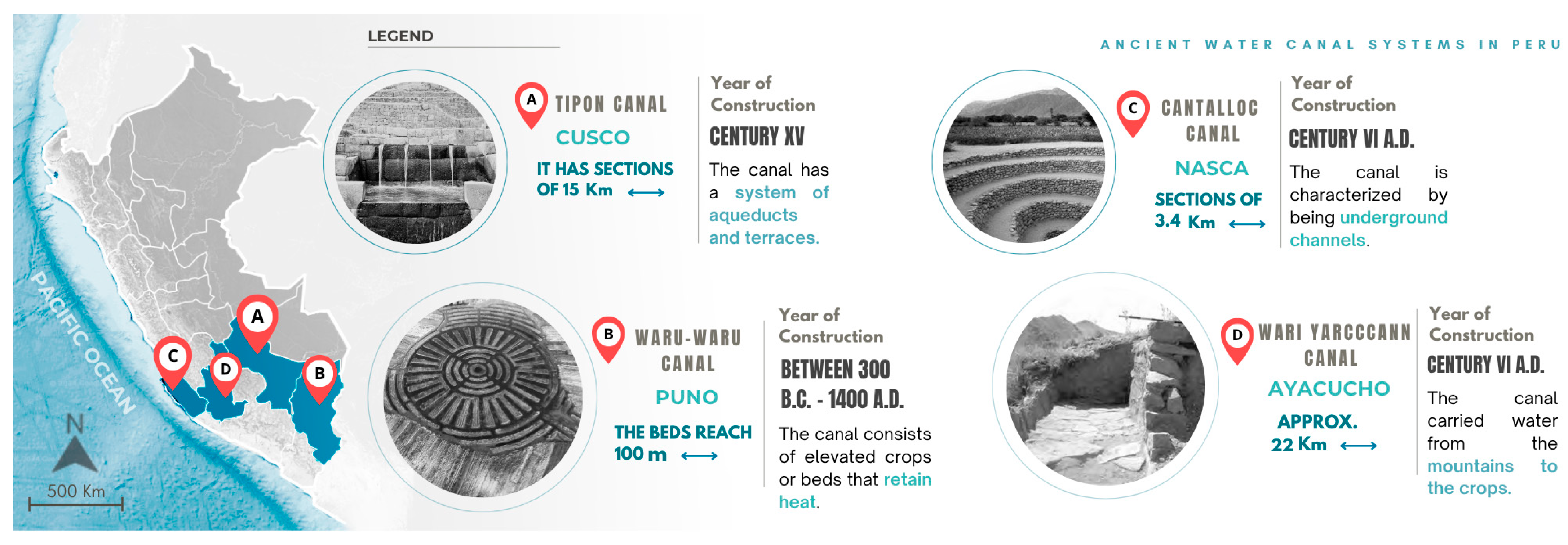
2. Materials and Methods
2.1. Methodological Framework
2.2. Methodological Process
2.2.1. Literature Review
2.2.2. Study Analysis, Climatic Analysis, and Flora
- Collection of hydrometeorological data from SENAMHI for the Magdalena meteorological station over the past five years (2020–2024), including maximum and minimum temperatures (°C), relative humidity (%), and precipitation (mm). This information made it possible to analyze average climatic conditions and their variations.
- Additional historical records from Climate-Data for the year 2024 were considered to complement the climatic analysis and obtain a more comprehensive view of the meteorological conditions in Cajamarca.
- A detailed statistical evaluation of the information obtained was carried out, with the aim of identifying climatic trends that have influenced the design and conservation of the Cumbemayo hydraulic system.
- A summary climate chart was prepared, including the parameters mentioned in the previous points.
2.2.3. Analysis of Water Supply and Functioning
2.2.4. Results
2.2.5. Discussions and Conclusions
2.3. Study Area
2.4. Climatic Analysis
2.5. Analysis of Flora
2.6. Analysis of Water Supply and Functioning
3. Results
3.1. Site Analysis and Solar Rotation
3.2. Spatial Analysis
3.2.1. Topographic Analysis
3.2.2. Zoning and Dimension
3.2.3. Adaptation to the Environment
3.2.4. Rhythm and Design
3.3. Functional Analysis
3.3.1. Hydraulic Design and Flow Regulation in the Cumbemayo Canal
3.3.2. Symbolism
3.4. Constructive Systems and Materials Analysis
4. Discussion
5. Conclusions
Author Contributions
Funding
Data Availability Statement
Acknowledgments
Conflicts of Interest
References
- World Bank. Gestión de los Recursos Hídricos. Available online: https://www.bancomundial.org/es/topic/waterresourcesmanagement (accessed on 29 June 2025).
- Rodà, I. Acueductos, una obra Maestra de la Ingeniería Romana. National Geographic. 2023. Available online: https://historia.nationalgeographic.com.es/a/acueductos-obra-maestra-ingenieria-romana_19151 (accessed on 12 April 2024).
- World History Encyclopedia. Available online: https://www.worldhistory.org/trans/es/1-518/acueducto/ (accessed on 12 April 2024).
- INAH Chihuahua. Available online: https://www.inahchihuahua.gob.mx/sections.pl?id=43 (accessed on 1 July 2025).
- World History Encyclopedia. Available online: https://www.worldhistory.org/trans/es/1-17206/jardines-colgantes-de-babilonia/ (accessed on 29 June 2025).
- Needell, J.D. Mere Gutter: The Carioca Aqueduct and Water Delivery in Mid-Nineteenth-Century Rio de Janeiro. Urban Hist. 1987, 14, 23–45. [Google Scholar]
- Ancajima, R. Inca Hydraulics. Available online: https://hidraulicainca.com (accessed on 12 April 2024).
- Waru Waru—Puno. Inca Hydraulics. 2013. Available online: https://hidraulicainca.com/puno/waru-waru-puno/ (accessed on 15 February 2025).
- Deza-Rivasplata, J.D.R. El Agua de los Incas: Sistema de Riego en el Perú Prehispánico; Universidad Alas Peruanas, 2010; pp. 1–85. Available online: https://repositorio.uap.edu.pe/xmlui/handle/20.500.12990/9621 (accessed on 12 April 2024).
- Schreiber, K.J.; Lancho Rojas, J. Aguas en el Desierto: Los Puquios de Nasca; Pontificia Universidad Católica del Perú. Fondo Editorial, 2006; 321p, Available online: https://repositorio.pucp.edu.pe/index/handle/123456789/181450 (accessed on 12 April 2024).
- Pérez, I.; Salvatierra, A. El Canal de Agua que Abastecía a la Ciudad de Wari, Ayacucho: Proceso Constructivo y Componentes de Funcionalidad. Arqueol. Soc. 2012, 24, 283–300. Available online: https://www.researchgate.net/publication/353562728_EL_CA-872NAL_DE_AGUA_QUE_ABASTECIA_A_LA_CIUDAD_DE_WARI_AYACUCHO_PROCESO_CONSTRUCTIVO_Y_COMPO-873NENTES_DE_FUNCIONALIDAD (accessed on 12 April 2024).
- Nature and Interpretation Peru, Nandi Peru (nandi Peru). Técnica Agrícola Hidráulica Ancestral: Waru Waru/Sukaqullu/Camellón—Puno Perú. 2022. Available online: https://ip.nandiperu.com/blog/tecnica-agricola-hidraulica-ancestral-waru-waru-sukaqullu-camellon-puno-peru/ (accessed on 12 April 2024).
- Ministerio de Desarrollo Agrario y Riego (MIDAGRI). Ríos. Available online: https://www.midagri.gob.pe/portal/42-sector-801875agrario/recurso-agua/325-rios (accessed on 12 April 2024).
- Autoridad Administrativa del Agua—Titicaca Drupal. Available online: https://www.ana.gob.pe/organos-desconcentrados/autoridad-administrativa-del-agua-titicaca (accessed on 9 August 2025).
- León, A.; Ripa, A. La Cuenca Intramontañosa de Cajamarca: Significado del Registro de Incisiones y Relleno para la Orogenia Andina en el Norte del Perú. Gob.pe. Available online: https://app.ingemmet.gob.pe/biblioteca/pdf/CPG18-154.pdf (accessed on 28 January 2025).
- Sanchez Peña, M.; Arana Maestre, J.; Cruz Gutierrez, J. Ecological assessment of the fluvial ecosystem of the Chonta River with mining influence in northern Peru. In Education, Research and Leadership in Post-Pandemic Engineering: Resilient, Inclusive and Sustainable Actions, Proceedings of the 20th LACCEI International Multi-Conference for Engineering, Education and Technology; Boca Raton, FL, USA, 18–22 July 2022; Available online: https://laccei.org/LACCEI2022-BocaRaton/meta/FP54.html (accessed on 12 April 2024).
- Deza Rivasplata, J.; Castañeda-Norie, H. Hierofanía y matemática del canal Cumbemayo, Cajamarca, Perú. Cienc. Desarro. 2024, 23, 67–101. Available online: https://dialnet.unirioja.es/servlet/articulo?codigo=7697133 (accessed on 5 February 2025). [CrossRef]
- Deza-Rivasplata, J. Cumbemayo, el Camino del Agua; Universidad Alas Peruanas, Lima, Peru. 2012. Available online: https://issuu.com/destinocajamarca/docs/cumbemayo_-_el_camino_del_agua (accessed on 20 January 2025).
- Izarra, P.P. El agua en el Perú: Pasado, Presente y Futuro. Com.ar. 2013. Available online: https://www.produccion-animal.com.ar/agua_cono_sur_de_america/63-Agua_incas.pdf (accessed on 20 January 2025).
- López Aldave, N.L. La sacralidad del agua en Kumbe Mayo Perú. Cuad. Arte Prehistórico 2021, 12, 220–244. Available online: https://www.academia.edu/49513866/La_sacralidad_del_agua_en_Kumbe_Mayo_Peru (accessed on 2 February 2025).
- Ponen en valor Complejo Arqueológico Cumbemayo en la Región Cajamarca. Gob. pe. Available online: https://www.gob.pe/institucion/cultura/noticias/620574-ponen-en-valor-complejo-arqueologico-cumbemayo-en-la-region-cajamarca (accessed on 25 January 2025).
- Cuya, N.; Estrada, P.; Esenarro, D.; Vega, V.; Vilchez Cairo, J.; Mancilla-Bravo, D.C. Comfort for Users of the Educational Center Applying Sustainable Design Strategies, Carabayllo-Peru-2023. Buildings 2024, 14, 2143. [Google Scholar] [CrossRef]
- Esenarro, D.; Vilchez, J.; Adrianzen, M.; Raymundo, V.; Gómez, A.; Cobeñas, P. Management Techniques of Ancestral Hydraulic Systems, Nasca, Peru; Marrakech, Morocco; and Tabriz, Iran in Different Civilizations with Arid Climates. Water 2023, 15, 3407. [Google Scholar] [CrossRef]
- Sánchez Rojas, A.; Vásquez Peralta, C. Mapa Climático Departamento de Cajamarca; Gobierno Regional de Cajamarca. 2010, pp. 1–33. Available online: https://zeeot.regioncajamarca.gob.pe/sites/default/files/MapaClimatico.pdf (accessed on 7 February 2025).
- Datos Climáticos y Meteorológicos Históricos Simulados Para Cajamarca. Meteoblue. Available online: https://www.meteoblue.com/en/weather/historyclimate/climatemodelled/cajamarca_peru_3699088 (accessed on 18 January 2025).
- Senamhi—Stations. Gob.pe. Available online: https://www.senamhi.gob.pe/?&p=estaciones (accessed on 14 August 2024).
- Tafur Anzualdo, V.I.; Aguirre Chavez, F.; Vega-Guevara, M.; Esenarro, D.; Vilchez Cairo, J. Causes and Effects of Climate Change 2001 to 2021, Peru. Sustainability 2024, 16, 2863. [Google Scholar] [CrossRef]
- Journal Portal. Edu.ec. Available online: https://revistadigital.uce.edu.ec (accessed on 21 March 2025).
- Gob.pe. Available online: https://www.regioncajamarca.gob.pe/media/portal/KJDIG/documento/13281/INFORME_FINAL_CUMBEMAYO.pdf?r=1619620965 (accessed on 21 March 2025).
- Google Earth. Available online: https://earth.google.com/web/@-7.19275385,-78.56657382,3655.35427544a,5981.81835846d,35y,-9160h,0t,0r/data=CgRCAggBMikKJwolCiExWDBjRGlQSkhnOXpjSlFaNU1lOXVaYXRhNjZrMDcycEogAToDCgEwQgIIAEoICI-917el8QGEAE (accessed on 22 January 2025).
- Medina, G. Complejo Arqueológico de Cumbemayo en Cajamarca. Perú en Videos. 2023. Available online: https://www.peruenvideos.com/cumbemayo-en-cajamarca/ (accessed on 14 February 2025).
- Peruvian Company of Editorial Services S.A. EDITORA PERÚ. Cumbemayo: El Asombroso Bosque de Piedras Escondido en lo más alto de Cajamarca. 5 September 2021. Available online: https://andina.pe/agencia/noticia-cumbemayo-asombroso-bosque-piedras-escondido-lo-mas-alto-cajamarca-860089.aspx (accessed on 11 January 2025).
- Cumbemayo Canal—Inca Hydraulics. Available online: https://hidraulicainca.com/cajamarca/canal-cumbemayo/ (accessed on 5 July 2025).
- Calderón Gutiérrez, J.P.; Chávez Farro, R.R. Cumbemayo: Topography and Hydraulic Features of the Inca Canal; Kuntur Publishing: Cusco, Peru, 2024. [Google Scholar] [CrossRef]
- Ching, F.D.K. Arquitectura: Forma, espacio y Orden; GG Publishing: Barcelona, Spain, 2016; Available online: https://elateoriaarq.wordpress.com/wp-content/uploads/2016/12/arquitectura-forma-espacio-y-orden-francis-d-k-ching_redacted.pdf (accessed on 21 September 2024).
- Esenarro, D.; Lescano, J.; Chalco, B.; Tapia, N.; Vilchez Cairo, J.; Vargas Beltran, C.; Arriola, C.; Ruiz Reyes, R. Spatial, Functional, 931 and Constructive Analysis of the Water Resource at the Archaeological Center of Tipon, Cusco, Peru, 2023. Heritage 2024, 7, 6629–6656. [Google Scholar] [CrossRef]
- Huaman, F.; Esenarro, D.; Prado Meza, J.; Vilchez Cairo, J.; Vargas Beltran, C.; Alfaro Aucca, C.; Arriola, C.; Peña Calle, V. Biophysical, Spatial, Functional, and Constructive Analysis of the Pre-Hispanic Terraces of the Ancient City of Pisaq, Cusco, Peru, 2024. Heritage 2024, 7, 6526–6565. [Google Scholar] [CrossRef]
- Esenarro, D.; Arteaga, D.; Vilchez, J.; Villena, M.; Raymundo, V.; Sanchez, A. Structural System in Wood and Its Impact on Environmental Design in the Surfer Bungalow in Canoas, Tumbes, Peru. In Proceedings of the 8th ASRES International Conference on Intelligent Technologies (ICIT 2023), Banten, Indonesia, 15–17 December 2023; Tripathi, V.K., Arya, K.V., Rodriguez, C., Eds.; Lecture Notes in Networks and Systems; Springer: Singapore, 2025; Volume 1031, pp. 431–451. [Google Scholar] [CrossRef]
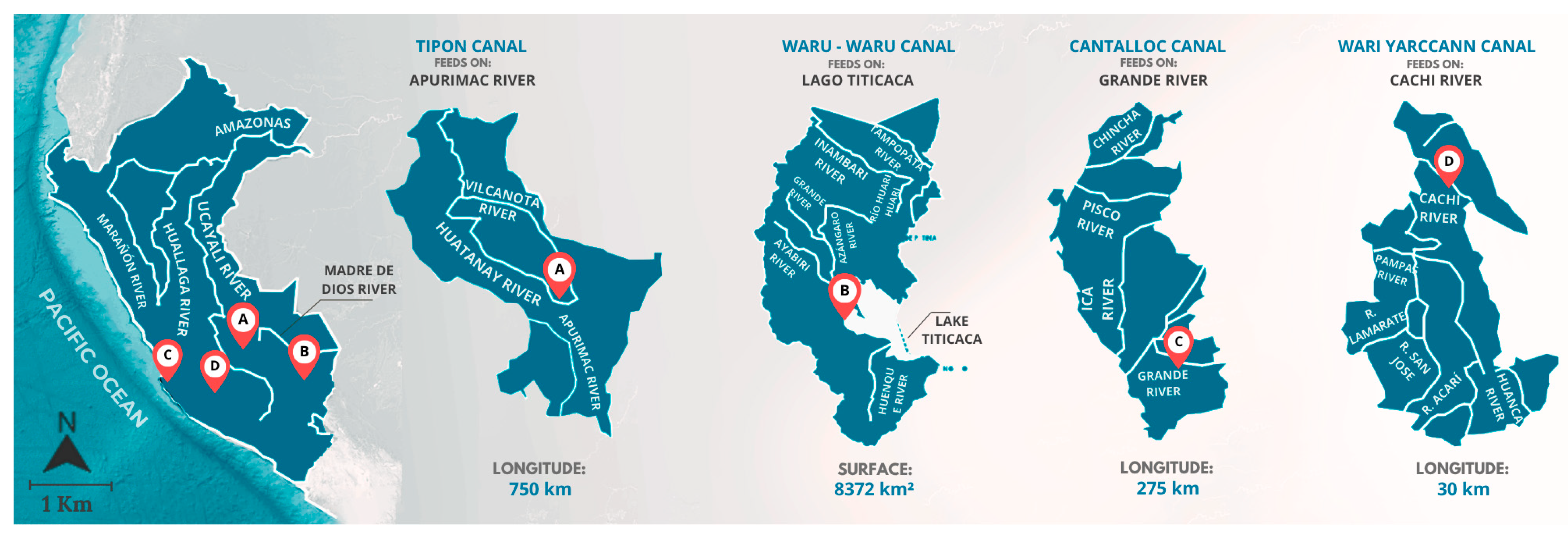

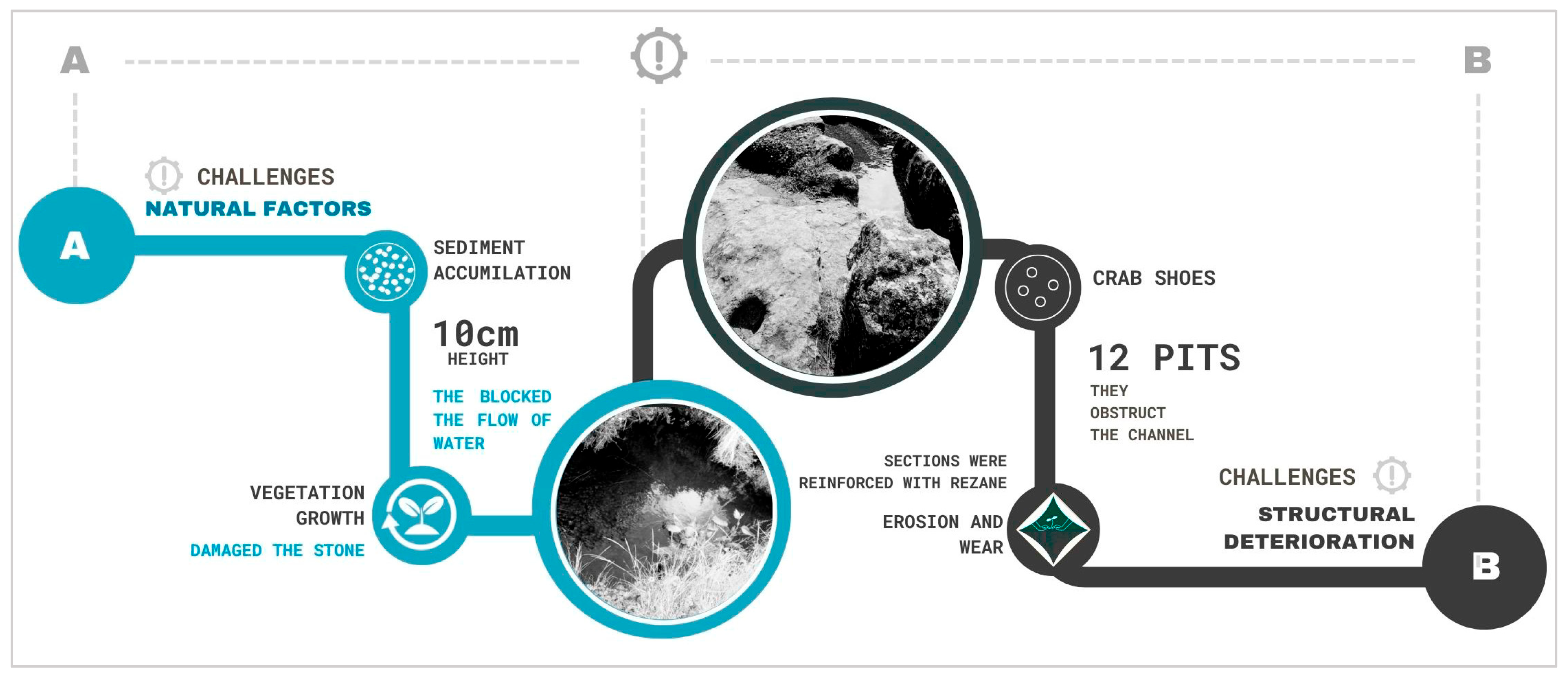
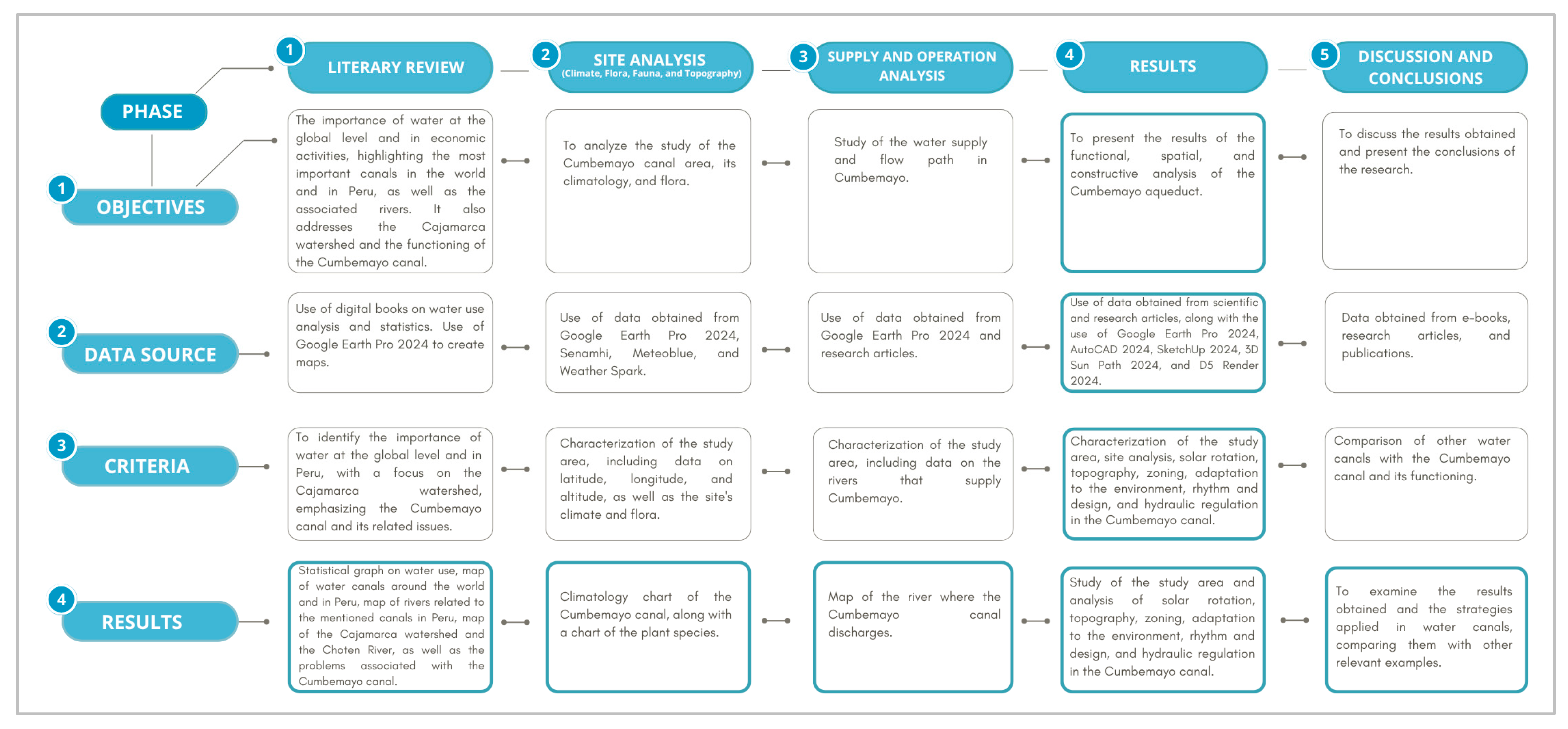

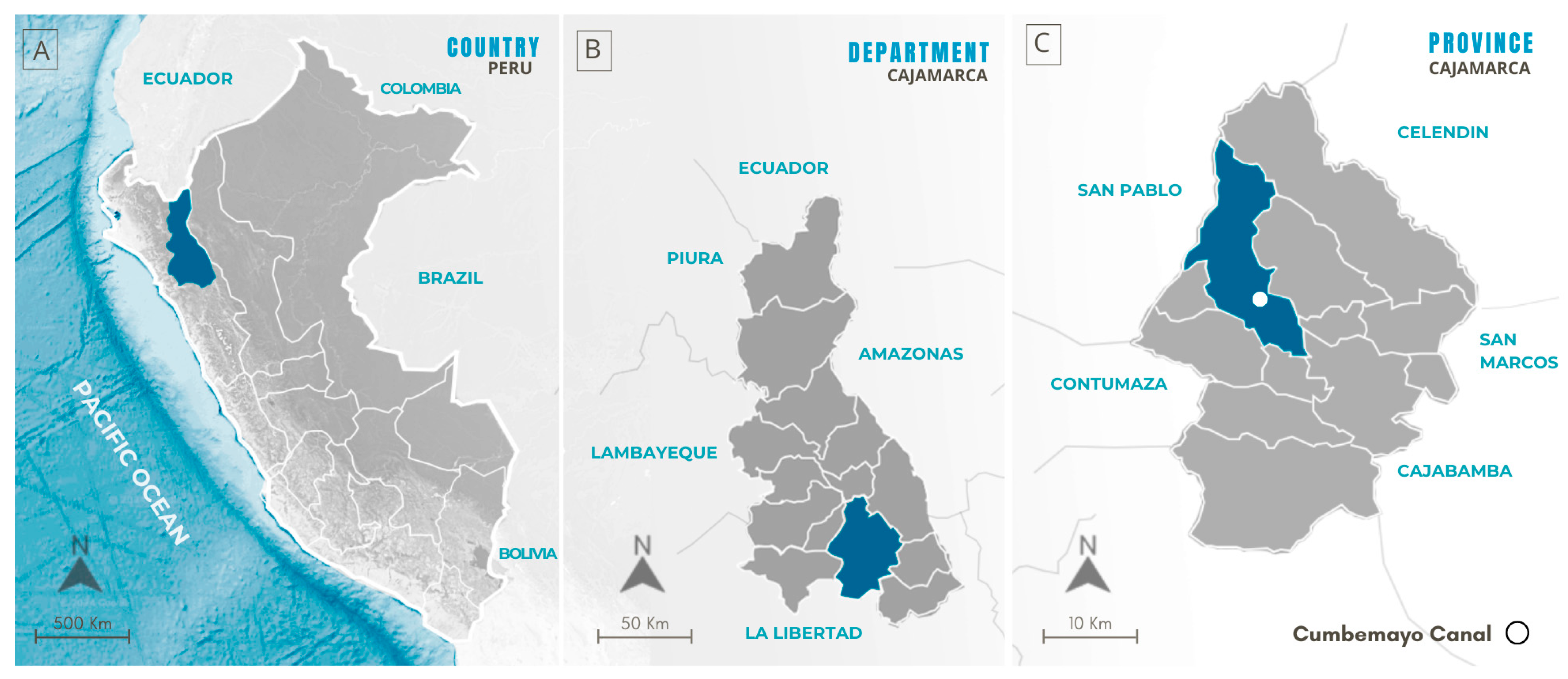
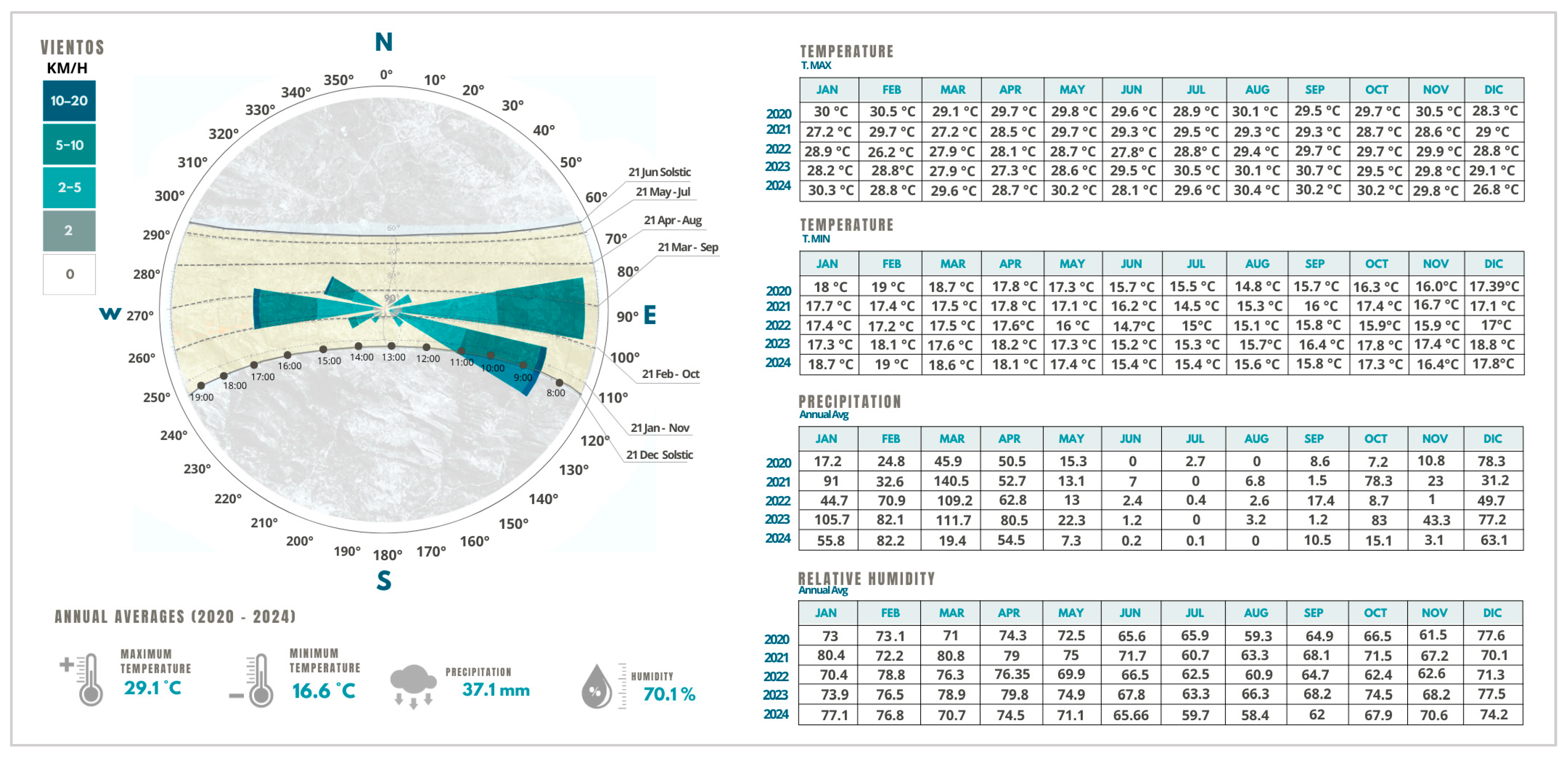
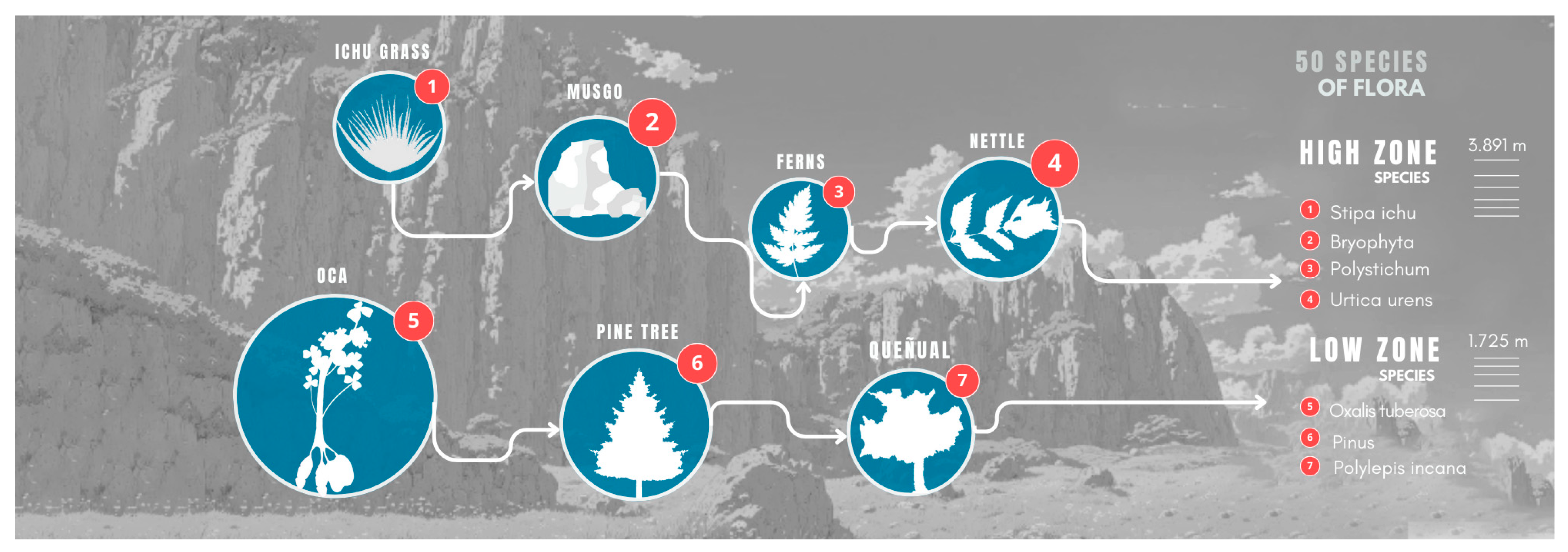
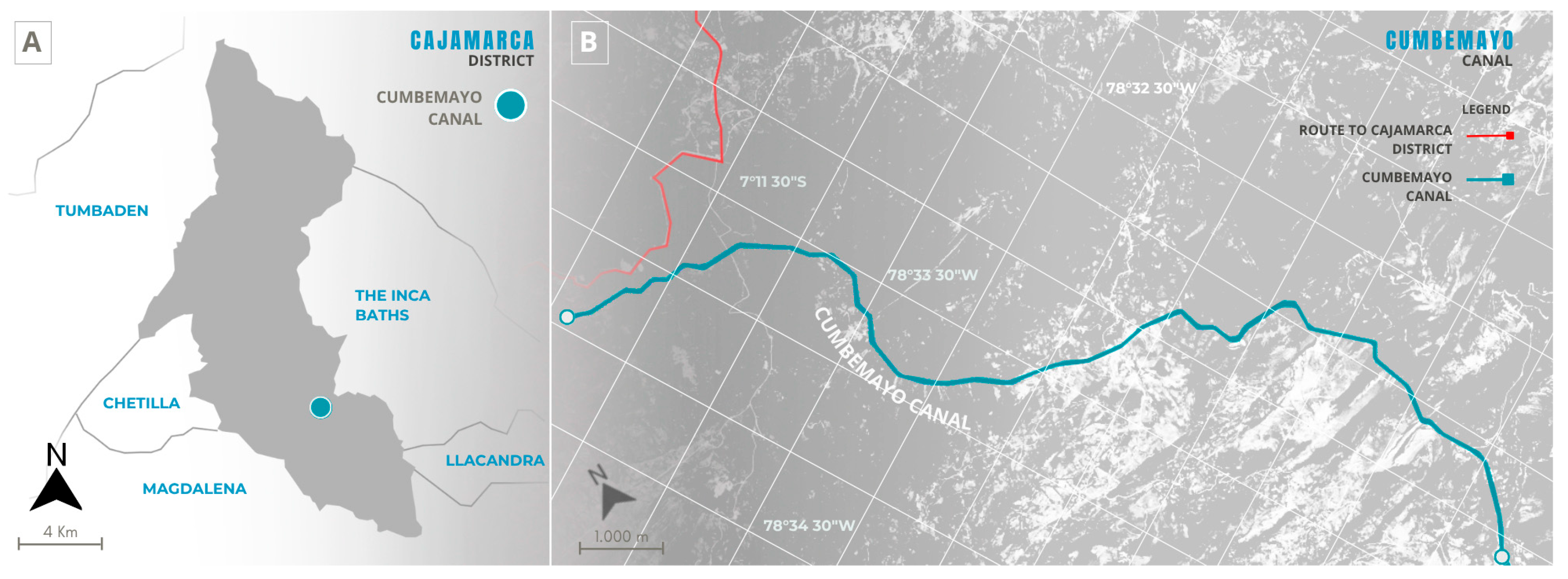
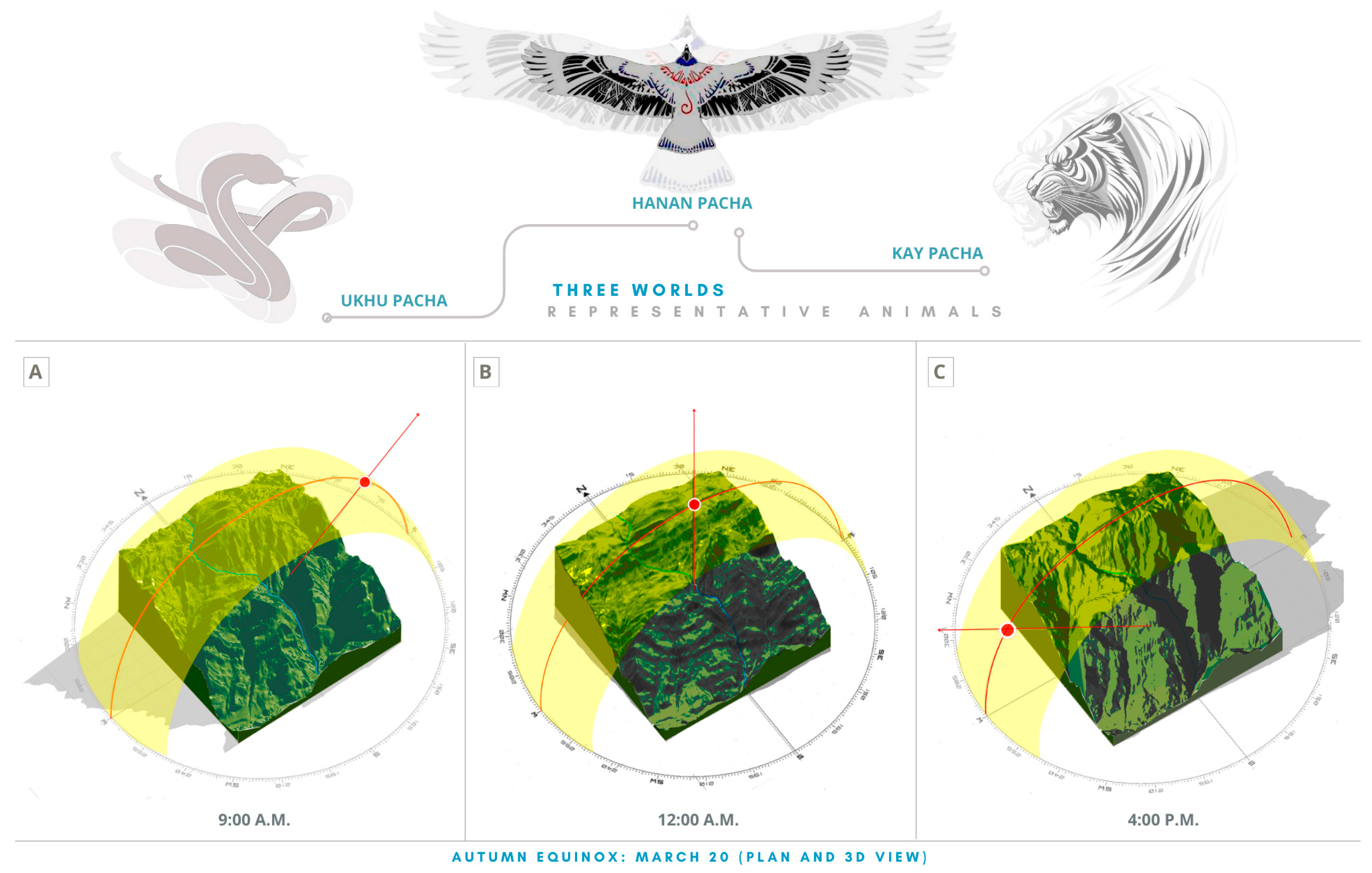

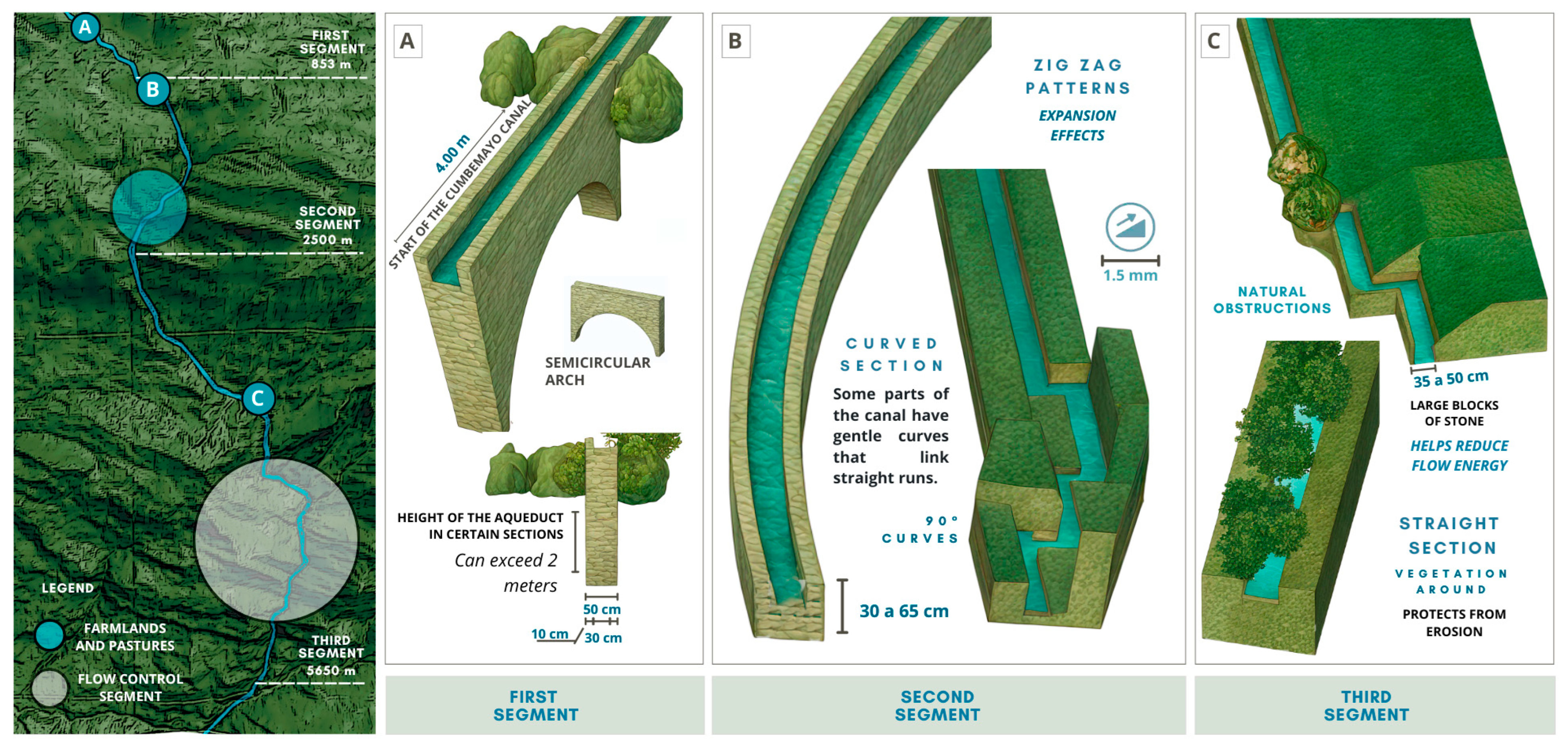

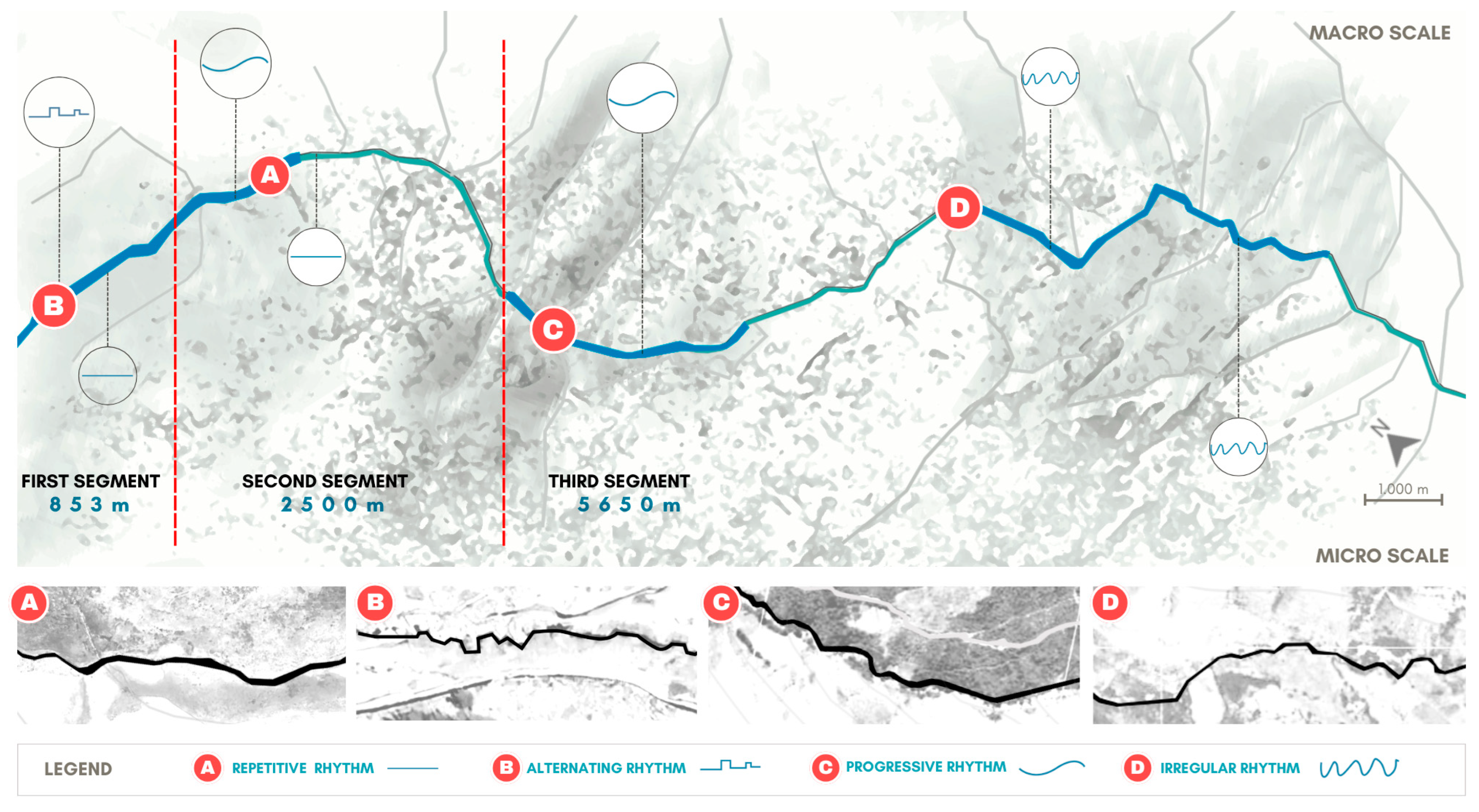
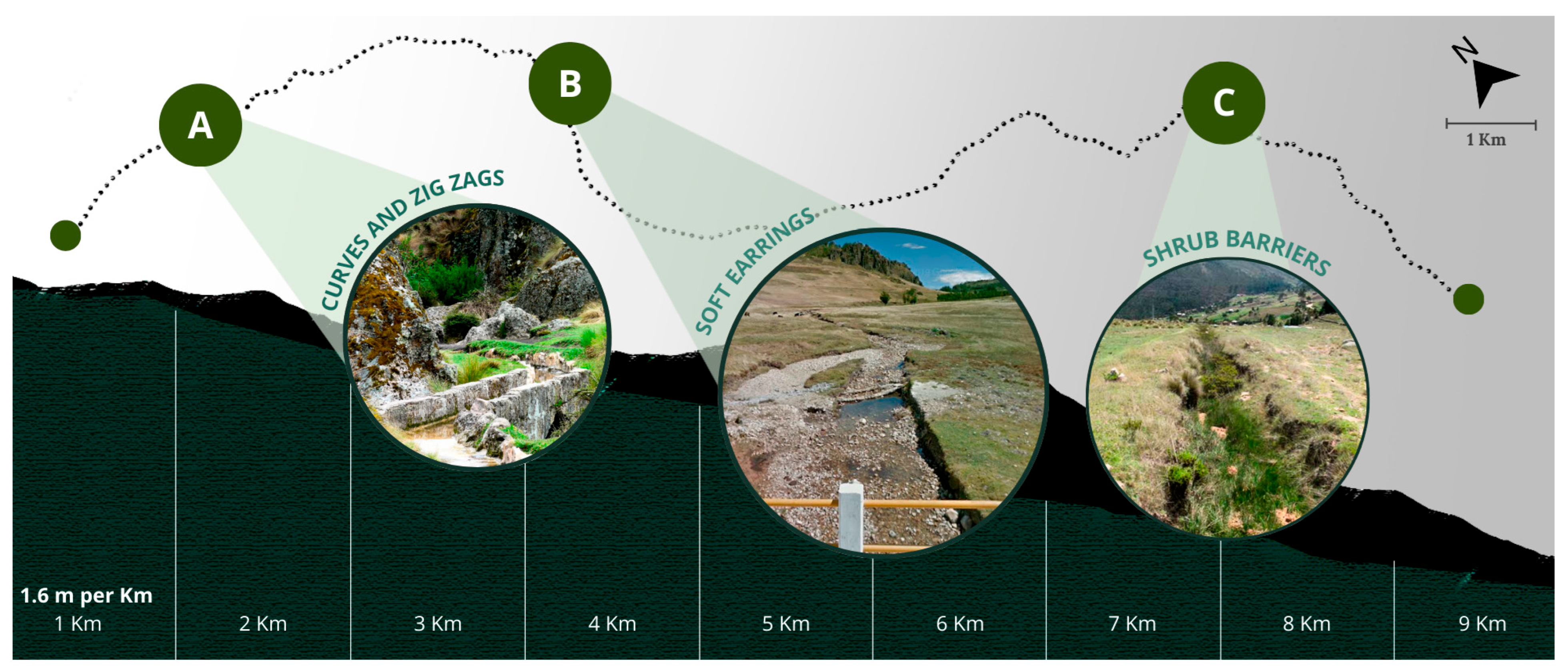

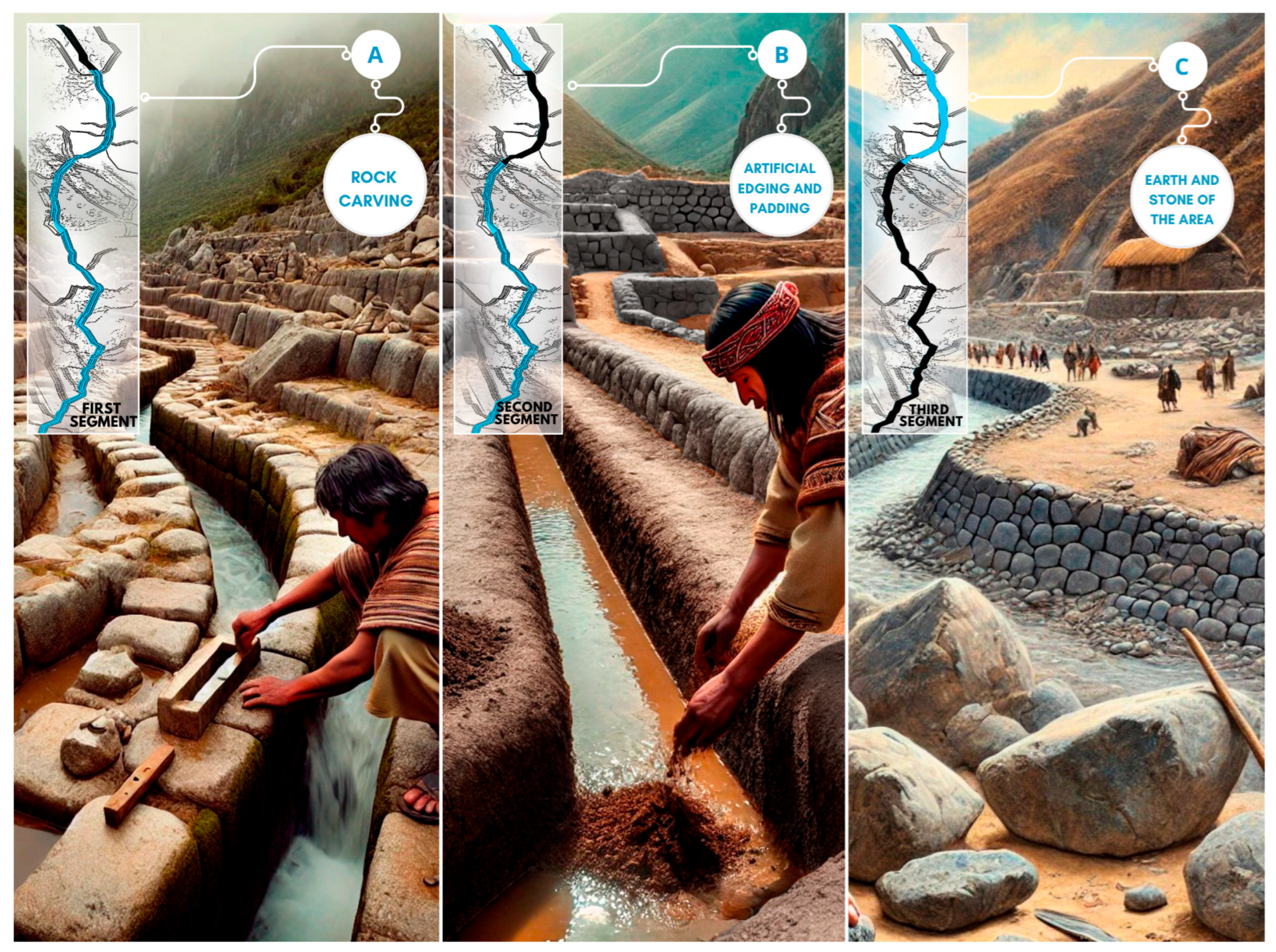
Disclaimer/Publisher’s Note: The statements, opinions and data contained in all publications are solely those of the individual author(s) and contributor(s) and not of MDPI and/or the editor(s). MDPI and/or the editor(s) disclaim responsibility for any injury to people or property resulting from any ideas, methods, instructions or products referred to in the content. |
© 2025 by the authors. Licensee MDPI, Basel, Switzerland. This article is an open access article distributed under the terms and conditions of the Creative Commons Attribution (CC BY) license (https://creativecommons.org/licenses/by/4.0/).
Share and Cite
Esenarro, D.; Palomino Gutierrez, D.; Santa Cruz Peña, K.; Vilchez Cairo, J.; Tafur Anzualdo, V.I.; Veliz Garagatti, M.; Salas Delgado, G.W.; Alfaro Aucca, C. Water Efficiency in the Construction of Water Channels and the Ancestral Constructive Sustainability of Cumbemayo, Peru. Heritage 2025, 8, 345. https://doi.org/10.3390/heritage8090345
Esenarro D, Palomino Gutierrez D, Santa Cruz Peña K, Vilchez Cairo J, Tafur Anzualdo VI, Veliz Garagatti M, Salas Delgado GW, Alfaro Aucca C. Water Efficiency in the Construction of Water Channels and the Ancestral Constructive Sustainability of Cumbemayo, Peru. Heritage. 2025; 8(9):345. https://doi.org/10.3390/heritage8090345
Chicago/Turabian StyleEsenarro, Doris, Dayana Palomino Gutierrez, Katherin Santa Cruz Peña, Jesica Vilchez Cairo, Vicenta Irene Tafur Anzualdo, Maria Veliz Garagatti, Geoffrey Wigberto Salas Delgado, and Crayla Alfaro Aucca. 2025. "Water Efficiency in the Construction of Water Channels and the Ancestral Constructive Sustainability of Cumbemayo, Peru" Heritage 8, no. 9: 345. https://doi.org/10.3390/heritage8090345
APA StyleEsenarro, D., Palomino Gutierrez, D., Santa Cruz Peña, K., Vilchez Cairo, J., Tafur Anzualdo, V. I., Veliz Garagatti, M., Salas Delgado, G. W., & Alfaro Aucca, C. (2025). Water Efficiency in the Construction of Water Channels and the Ancestral Constructive Sustainability of Cumbemayo, Peru. Heritage, 8(9), 345. https://doi.org/10.3390/heritage8090345








